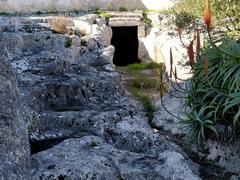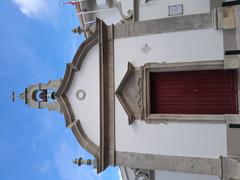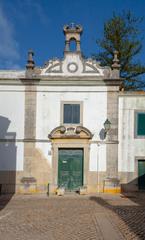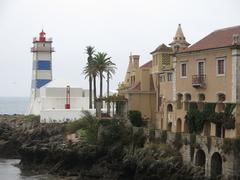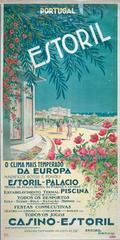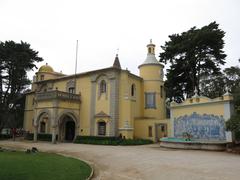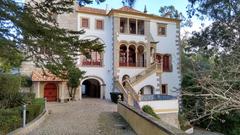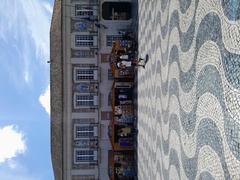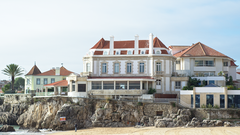
Fort of São Teodósio da Cadaveira: Visiting Hours, Tickets, and Historical Significance in Estoril, Portugal
Date: 03/07/2025
Introduction
Nestled on the scenic Estoril coastline, the Fort of São Teodósio da Cadaveira stands as a testament to Portugal’s rich maritime defense heritage. Built in 1642 during the reign of King John IV, this 17th-century fortification was part of a strategic network developed after the Portuguese Restoration War to protect Lisbon and its approaches from piracy and foreign naval threats. Named for Prince Teodósio, the fort played a critical role in safeguarding the vulnerable stretch between Lisbon and Cascais, and today remains a striking coastal landmark (Cascais Municipality, Direção-Geral do Património Cultural).
This guide details the fort’s history, architectural features, visiting information, travel tips, accessibility, and nearby attractions. Whether you are a history enthusiast, photographer, or traveler, this resource offers everything you need to make the most of your visit to one of Estoril’s most iconic historical sites.
Table of Contents
- Introduction
- Historical Context and Construction
- Architectural Features and Defensive Design
- Coastal Defense Role and Evolution
- Preservation and Modern Significance
- Visiting Hours, Tickets, and Accessibility
- Getting There and Travel Tips
- Nearby Attractions and Activities
- Frequently Asked Questions (FAQ)
- Visuals and Media
- Additional Resources
Historical Context and Construction
The Fort of São Teodósio da Cadaveira was constructed in 1642 as part of Portugal’s post-Restoration War (1640–1668) defense strategy. Positioned between Lisbon and Cascais, it was essential in creating a chain of fortifications to deter pirate raids and foreign incursions. Its strategic location atop a promontory provided commanding views of the Atlantic and facilitated coordination with neighboring forts (Monumentos Portugal).
Named for Prince Teodósio, the fort symbolized the Braganza dynasty’s role in Portugal’s independence and reflected both urgency and innovation in 17th-century military engineering (Visit Cascais).
Architectural Features and Defensive Design
The fort exemplifies 17th-century military architecture, featuring:
- Rectangular Layout: Compact, with robust limestone walls up to 2 meters thick.
- Bastions: Two angular bastions at seaward corners for overlapping fields of fire.
- Embrasures: Designed for artillery, allowing coverage of the coastline.
- Central Courtyard: Originally housed barracks, powder magazine, and storage.
- Gatehouse: Simple entrance, once equipped with a drawbridge over a shallow moat.
- Watchtowers (Guaritas): Three small 18th-century turrets for surveillance.
Despite its modest size, the fort’s elevated position above Praia da Poça offered a strategic advantage and panoramic ocean views (Lisbon Beaches Guide).
Coastal Defense Role and Evolution
The fort worked in unison with other coastal defenses such as the Fort of São Julião da Barra and the Fort of Nossa Senhora da Luz, forming a network capable of crossfire to deter enemy ships from accessing Lisbon via the Tagus estuary. It was garrisoned by small contingents and armed with cannons, serving both as an early warning post and a deterrent during periods of international tension.
By the 19th century, advances in naval warfare rendered the fort obsolete, leading to its adaptation for civilian uses such as customs enforcement and railway support (Direção-Geral do Património Cultural).
Preservation and Modern Significance
Designated a Property of Public Interest in 1974, the fort has since undergone stabilization efforts, though active restoration remains limited. While interior access is currently restricted due to structural concerns, the exterior is well-preserved and serves as a prominent symbol of Estoril’s maritime heritage (Monumentos Portugal).
The fort’s silhouette, visible from Praia da Poça and the coastal promenade, is a favored subject for local artists and photographers, and it continues to play a role in community identity and cultural events (Visit Cascais).
Visiting Hours, Tickets, and Accessibility
- Interior Access: As of mid-2025, the interior remains closed due to preservation efforts and safety concerns.
- Exterior Visits: The fort’s exterior is accessible year-round during daylight hours. There are no established visiting hours or ticket requirements for viewing the site from outside.
- Entry Fee: Visiting the exterior is free of charge.
- Accessibility: The site sits on uneven, rocky terrain. Accessibility for those with mobility challenges is limited, and visitors should exercise caution (Touristic Routes).
- Facilities: No on-site amenities (restrooms, visitor center). Cafés, shops, and other facilities are available within a 10–15 minute walk.
Getting There and Travel Tips
- Location: São João do Estoril, Cascais, between Poça Beach (Praia da Poça) and Azarujinha Beach.
- By Train: 10-minute walk from São João do Estoril station on the Lisbon–Cascais line.
- By Car: Limited street parking; consider public transport during peak seasons.
- Cycling: The scenic coastal promenade is ideal for walking or cycling; local bike rentals, including free “Bicas” bikes, are available (SintraCascaisSesimbra.com).
- Best Time to Visit: Late spring to early autumn (May to October) for pleasant weather; early morning or late afternoon for photography.
Travel Tips:
- Bring comfortable walking shoes and sun protection.
- Supervise children closely due to uneven terrain.
- Use local guides for broader historical tours of the Estoril coastline.
Nearby Attractions and Activities
Enhance your visit by exploring:
- Praia da Poça: Family-friendly beach just east of the fort.
- Azarujinha Beach: Known for dramatic cliffs and clear waters.
- Estoril Casino and Gardens: Art deco casino with cultural events and beautiful grounds.
- Fort of São Pedro do Estoril: Larger fort with cultural programming.
- Estoril Promenade: Coastal path ideal for walking, jogging, or cycling.
- Day Trips: Cascais, Sintra, and Lisbon are easily accessible from Estoril.
After your visit, relax at nearby cafés or sample local seafood to immerse yourself in the area’s laid-back ambiance (SintraCascaisSesimbra.com).
Frequently Asked Questions (FAQ)
Q: Is there an entrance fee or ticket required?
A: No, exterior visits are free and do not require tickets.
Q: Is the interior open to the public?
A: The interior is closed due to preservation efforts; only the exterior is accessible.
Q: How do I reach the fort by public transport?
A: Take the Lisbon–Cascais train line to São João do Estoril station; the fort is a 10-minute walk away.
Q: Are guided tours available?
A: No official tours focus solely on the fort, but it is often included in broader local heritage or coastal tours (Touristic Routes).
Q: Is the site accessible for visitors with mobility challenges?
A: The terrain is uneven and rocky, so accessibility is limited.
Visuals and Media
Visitors can find high-quality images and virtual tours on local tourism websites. Including maps and interactive guides to the Estoril coastline can help plan your visit and enhance the experience. For SEO, use image alt text such as “Forte de São Teodósio da Cadaveira coastal fortification in Estoril.”
Additional Resources
- Cascais Municipality
- Direção-Geral do Património Cultural
- Visit Cascais
- Monumentos Portugal
- Touristic Routes
- Lisbon Beaches Guide
- Portugalidade Blog
- SintraCascaisSesimbra.com
Conclusion and Call to Action
The Fort of São Teodósio da Cadaveira is a distinguished symbol of Portugal’s maritime defense system and coastal heritage. While interior access is currently unavailable, the fort’s exterior and scenic location make it a rewarding stop for anyone interested in military history, architecture, or the natural beauty of the Estoril coastline. Plan your visit to coincide with daylight hours, explore nearby beaches and historical sites, and enjoy the tranquil atmosphere that characterizes this unique region.
For up-to-date information on restoration efforts, events, and guided tours, consult official local tourism resources. Download the Audiala app for guided audio tours, exclusive content, and the latest updates on Estoril’s historical attractions. Follow us on social media for news and inspiration as you discover Portugal’s captivating Atlantic coast.


